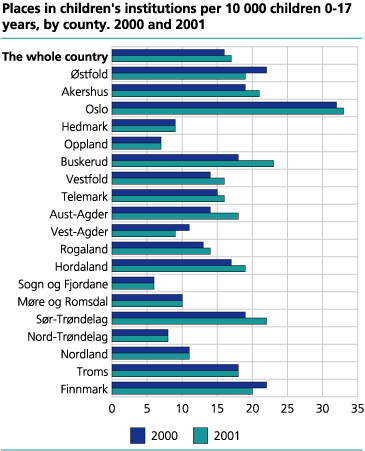Content
Published:
This is an archived release.
One million NOK per place in an institution
A place in a childrens institution cost an average of NOK 1 030 000 in 2001. This is 7 per cent more than the previous year. The costs per institutional place vary greatly. The places in acute ward institutions and in living/working collectives were the most expensive.
In institutions for parents and children (maternity homes), which were the least expensive, a place cost NOK 606 000. By comparison, the price in the childrens and youths homes, where about half of the places are located, came to NOK 1 039 000 per year on the average. The places in acute ward institutions and in living/working collectives, which are most expensive, cost an average of NOK 1 244 000 and NOK 1 187 000 per year, respectively.
Half of the institutions are public
The public sector owns and operates half of the childrens institutions, i.e. 52 per cent. The county municipalities are responsible for the great majority of these institutions (92 per cent). Private organisations and foundations own the rest of the institutions.
205 institutions
In 2001 a total of 205 childrens institutions were registered with a total of 1 853 places, compared with 1 724 places and 183 institutions in 2000. The distribution in 2001 was as follows: 18 childrens homes, 80 youths homes, 22 combined childrens and youths homes, 14 institutions for parents and children (maternity homes), 21 living/working collectives, 31 acute ward institutions and 19 other institutions. About six out of ten childrens institutions (59 per cent) are currently either childrens or youths homes, i.e. institutions that offer residence to children and youths who need it. Many of these institutions have some acute places in addition to places for long-term child welfare placements.
Of a total of 1 853 places, 825 places (45 per cent) are owned by the public sector. The majority, i.e. 1 028 places, are owned by private organisations and foundations.
Oslo has the best degree of coverage
One measure of the degree of coverage is the number of places in relation to the number of children under 18 years of age in each county. The places in each individual institution are distributed among the counties that made the places available on a given date when they were counted.
For the country as a whole, the degree of coverage in 2001 was 17 places per 10 000 children under age 18, compared with 16 places in 2000. Oslo still tops the list with 33 places per 10 000 children. Sogn og Fjordane and Oppland still had the lowest coverage with six and seven places per 10 000 children respectively.
3 742 man-years
A total of 3 742 man-years were worked out at the 205 institutions in 2001, compared with 3 379 man-years at 183 institutions in 2000. This is 2.0 man-years per place, the same as in 2000. Residential child care workers are still the largest group of professionals with 25 per cent of all man-years in 2001, compared with 26 per cent in the previous year. Unskilled workers are still a large group, currently numbering 28 per cent of all employees, the same as in the previous year.
Most boys
More than half of the 1 628 residents were boys (57 per cent). Six out of ten residents in children's institutions (59 per cent) belonged to the age group 14-17 years. Six out of ten residents had at the end of 2001 been living there less than one year, and one out of ten (11 per cent) more than 3 years.
Operating expenses of NOK 1.8 billion
Of the 205 institutions that were in use in 2001 we lack economic information from ten. Thus, the calculation of costs per place is based on only 195 institutions with 1 760 places. The gross operating expenses for these were more than NOK 1.8 billion.
Places in institutions owned by the public sector are about ten per cent more expensive per year than those owned by private organisations and foundations, NOK 1 087 000 and NOK 980 000 per year respectively. The explanation might be that public sector own more acute ward institutions which are the most expensive ones. If we compare the prices in children's and youth's institutions, there is only a small difference, NOK 1 050 000 and NOK 1 025 000 per year.
Tables:
- Table 1 Number of beds in children's institutions, by type of institution, ownership and by county. Per 15 January 2002
- Table 2 Residents in children's institutions, by type of institution, sex and age. Per 15 January 2002
- Table 3 Residents in children's institutions, by type of institution and duration of the stay. Per 15 January 2002
- Table 4 Man-years in children's institutions, by type of institution, ownership and occupation. Per 15 January 2002
- Table 5 Gross expenditure for children's institutions, by type of institution, ownership and county. 2001. 1 000 kroner
Contact
-
Tone Dyrhaug
E-mail: tone.dyrhaug@ssb.no
tel.: (+47) 40 90 24 20
-
Unni Beate Grebstad
E-mail: unni.grebstad@ssb.no
tel.: (+47) 94 50 68 66

